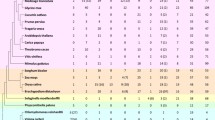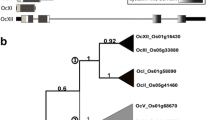Abstract
The squash (Cucurbita maxima) phloem exudate-expressed aspartic proteinase inhibitor (SQAPI) is a novel aspartic acid proteinase inhibitor, constituting a fifth family of aspartic proteinase inhibitors. However, a comparison of the SQAPI sequence to the phytocystatin (a cysteine proteinase inhibitor) family sequences showed ∼30% identity. Modeling SQAPI onto the structure of oryzacystatin gave an excellent fit; regions identified as proteinase binding loops in cystatin coincided with regions of SQAPI identified as hypervariable, and tryptophan fluorescence changes were also consistent with a cystatin structure. We show that SQAPI exists as a small gene family. Characterization of mRNA and clone walking of genomic DNA (gDNA) produced 10 different but highly homologous SQAPI genes from Cucurbita maxima and the small family size was confirmed by Southern blotting, where evidence for at least five loci was obtained. Using primers designed from squash sequences, PCR of gDNA showed the presence of SQAPI genes in other members of the Cucurbitaceae and in representative members of Coriariaceae, Corynocarpaceae, and Begoniaceae. Thus, at least four of seven families of the order Cucurbitales possess member species with SQAPI genes, covering ∼99% of the species in this order. A phylogenetic analysis of these Cucurbitales SQAPI genes indicated not only that SQAPI was present in the Cucurbitales ancestor but also that gene duplication has occurred during evolution of the order. Phytocystatins are widespread throughout the plant kingdom, suggesting that SQAPI has evolved recently from a phytocystatin ancestor. This appears to be the first instance of a cystatin being recruited as a proteinase inhibitor of another proteinase family.






Similar content being viewed by others
References
Altschul SF, Madden TL, Schaffer AA, Zhang J, Zhang Z, Miller W, Lipman DJ (1997) Gapped BLAST and PSI-BLAST: a new generation of protein database search programs. Nucleic Acids Res 25:3389–3402
Choi D, Park JA, Seo YS, Chun YJ, Kim WT (2000) Structure and stress-related expression of two cDNAs encoding proteinase inhibitor II of Nicotiana glutinosa L. Biochim Biophys Acta 1492:211–215
Christeller JT (2005) Evolutionary mechanisms acting on proteinase inhibitor variability. FEBS J 272:5710–5722
Christeller JT, Laing WA (2005) Plant serine proteinase inhibitors. Protein Peptide Lett 12:439–447
Christeller JT, Farley PC, Ramsay RJ, Sullivan PA, Laing WA (1998) Purification, characterization and cloning of an aspartic proteinase inhibitor from squash phloem exudate. Eur J Biochem 254:160–167
Creighton TE, Darby NJ (1989) Functional evolutionary divergence of proteolytic enzymes and their inhibitors. Trends Biochem Sci 14:319–324
Doyle A (1990) Isolation of plant DNA from fresh tissue. Focus 12:13–15
Farley PC, Christeller JT, Sullivan ME, Sullivan PA, Laing WA (2002) Analysis of the interaction between the aspartic peptidase inhibitor SQAPI and aspartic peptidases using surface plasmon resonance. J Mol Recognit 15:135–144
Felsenstein J (2002) PHYLIP: Phylogeny Inference Package, version 3.6, Department of Genome Sciences, University of Washington, Seattle
Galleschi L, Friggeri M, Repiccioli R, Come D, Corbineau F (1993) Aspartic proteinase inhibitor from wheat: some properties. In: Proceedings of the Fourth International Workshop on Seeds: Basic and Applied Aspects of Seed Biology, Angers, France, 20–24 July 1992. ASFIS, Paris, Vol 1, pp 207–211
Guex N, Peitsch MC (1997) SWISS-MODEL and the Swiss-PdbViewer: an environment for comparative protein modelling. Electrophoresis 18:2714–2723
Hill RE, Hastie ND (1987) Accelerated evolution in the reactive centre regions of serine protease inhibitors. Nature 326:96–99
Hooft RWW, Vriend G, Sander C, Abola EE (1996) Errors in protein structures. Nature 381:272
Komiyama T, Ray C, Pickup D, Howard A, Thornberry N, Peterson E, Salvesen G (1994) Inhibition of interleukin-1 beta converting enzyme by the cowpox virus serpin CrmA. An example of cross-class inhibition. J Biol Chem 269:19331–19337
Krizaj I, Drobnic-Kosorok M, Brzin J, Jerala R, Turk V (1993) The primary structure of inhibitor of cysteine proteinases from potato. FEBS Lett 333:15–20
Laing WA, Barraclough D, Bulley S, Cooney J, Wright M, Macrae E (2004) A specific L-galactose-1-phosphate phosphatase on the path to ascorbate biosynthesis. Proc Natl Acad Sci USA 101:16976–16981
Laskowski M, Kato I (1980) Protein inhibitors of proteinases. Annu Rev Biochem 49:593–626
Laskowski M Jr, Kato I, Ardelt W, et al. (1987a) Ovomucoid third domains from 100 avian species: isolation, sequences, and hypervariability of enzyme-inhibitor contact residues. Biochemistry 26:202–221
Laskowski M Jr, Kato I, Kohr WJ, Park SJ, Tashiro M, Whatley HE (1987b) Positive darwinian selection in evolution of protein inhibitors of serine proteinases. Cold Spring Harbor Symp Quant Biol 52:545–553
Lenarcic B, Turk V (1999) Thyroglobulin type-1 domains in equistatin inhibit both papain-like cysteine proteinases and cathepsin D. J Biol Chem 274:563–566
Li M, Phylip LH, Lees WE, Winther JR, Dunn BM, Wlodawer A, Kay J, Gustchina A (2000) The aspartic proteinase from Saccharomyces cerevisiae folds its own inhibitor into a helix. Nat Struct Biol 7:113–117
Mares M, Meloun B, Pavlik M, Kostka V, Baudys M (1989) Primary structure of the cathepsin D inhibitor from potatoes and its structural relationship to soybean trypsin inhibitor family. FEBS Lett 251:94–98
Margis R, Reis EM, Villeret V (1998) Structural and phylogenetic relationships among plant and animal cystatins. Arch Biochem Biophys 359:24–30
Martzen MR, McMullen BA, Smith NE, Fujikawa K, Peanasky RJ (1990) Primary structure of the major pepsin inhibitor from the intestinal parasitic nematode Ascaris suum. Biochemistry 29:7366–7372
Mathialagan N, Hansen TR (1996) Pepsin-inhibitory activity of the uterine serpins. Proc Natl Acad Sci USA 93:13653–13658
Murray C, Christeller JT (1995) Purification of a trypsin inhibitor (PFTI) from pumpkin fruit phloem exudate and isolation of putative trypsin and chymotrypsin inhibitor cDNA clones. Biol Chem Hoppe Seyler 376:281–287
Nagata K, Kudo N, Abe K, Arai S, Tanokura M (2000) Three-dimensional solution structure of oryzacystatin-I; a cysteine proteinase inhibitor of the rice, Oryza sativa L. japonica. Biochemistry 39:14753–14760
Newcomb RD, Crowhurst RN, Gleave AP, Rikkerink EH, Allan AC, Beuning LL, Bowen JH, Gera E, Jamieson KR, Janssen BJ, Laing WA, McArtney S, Nain B, Ross GS, Snowden KC, Souleyre EJ, Walton EF, Yauk YK (2006) Analyses of expressed sequence tags from apple (Malus x domestica). Plant Physiol 141:147–166
Ng KK, Petersen JF, Cherney MM, Garen C, Zalatoris JJ, Rao-Naik C, Dunn BM, Martzen MR, Peanasky RJ, James MN (2000) Structural basis for the inhibition of porcine pepsin by Ascaris pepsin inhibitor-3. Nat Struct Biol 7:653–657
Page RDM (1996) TREEVIEW: Aan application to display phylogenetic trees on personal computers. Comput Appl Biosci 12:357–358
Peitsch MC (1995) Protein modeling by E-mail. Bio/Technology 13:658–660
Rassam M, Laing WA (2004) Purification and characterization of phytocystatins from kiwifruit cortex and seeds. Phytochemistry 65:19–30
Rawlings ND, Tolle DP, Barrett AJ (2004) Evolutionary families of peptidase inhibitors. Biochem J 378:705–716
Sambrook J, Fritsch EF, Maniatis T (1989) Molecular cloning. Cold Spring Harbor Laboratory Press, Cold Spring Harbor, NY
Schu P, Suarez Rendueles P, Wolf DH (1991) The proteinase yscB inhibitor (PB12 gene of yeast and studies on the function of its protein product. Eur J Biochem 197:1–7
Schwede T, Kopp J, Guex N, Peitsch MC (2003) SWISS-MODEL: an automated protein homology-modeling server. Nucleic Acids Res 31:3381–3385
Siebert PD, Chenchik A, Kellogg DE, Lukyanov KA, Lukyanov SA (1995) An improved PCR method for walking in uncloned genomic DNA. Nucleic Acids Res 23:1087–1088
Thompson JD, Gibson TJ, Plewniak F, Jeanmougin F, Higgins DG (1997) The ClustalX windows interface: flexible strategies for multiple sequence alignment aided by quality analysis tools. Nucleic Acids Res 24:4876–4882
Turk V, Bode W (1991) The cystatins: protein inhibitors of cysteine proteinases. FEBS Lett 285:213–219
Walsh TA, Strickland JA (1993) Proteolysis of the 85-kilodalton crystalline cysteine proteinase inhibitor from potato releases functional cystatin domains. Plant Physiol 103:1227–1234
Zhang L-B, Simmons MP, Kocyan A, Renner SS (2006) Phylogeny of the Cucurbitales based on DNA sequences of nine loci from three genomes: Implications for morphological and sexual system evolution. Mol Phylogenet Evol 35:305–322
Acknowledgments
We thank Mr. Andrew Clarke (Massey University, Palmerston North) for cucurbit seeds, Dr. Tony Lough (AgriGenesis Ltd., Auckland), Mr. Tom Rouse (Department of Conservation, Palmerston North) for plant material, Mr. Jonathon Proctor (Tanenuiarangi Manawatu Inc.) for advice on plant collection, and Gareth Cochran (Massey University, Palmerston North) for taking care of the plants. Finance was provided by the Public Good Science Fund of New Zealand (Contracts CO6X0207 and CO6X0220).
Author information
Authors and Affiliations
Corresponding author
Additional information
[Reviewing Editor: Dr. Antony Dean]
Rights and permissions
About this article
Cite this article
Christeller, J.T., Farley, P.C., Marshall, R.K. et al. The Squash Aspartic Proteinase Inhibitor SQAPI Is Widely Present in the Cucurbitales, Comprises a Small Multigene Family, and Is a Member of the Phytocystatin Family. J Mol Evol 63, 747–757 (2006). https://doi.org/10.1007/s00239-005-0304-z
Received:
Accepted:
Published:
Issue Date:
DOI: https://doi.org/10.1007/s00239-005-0304-z




